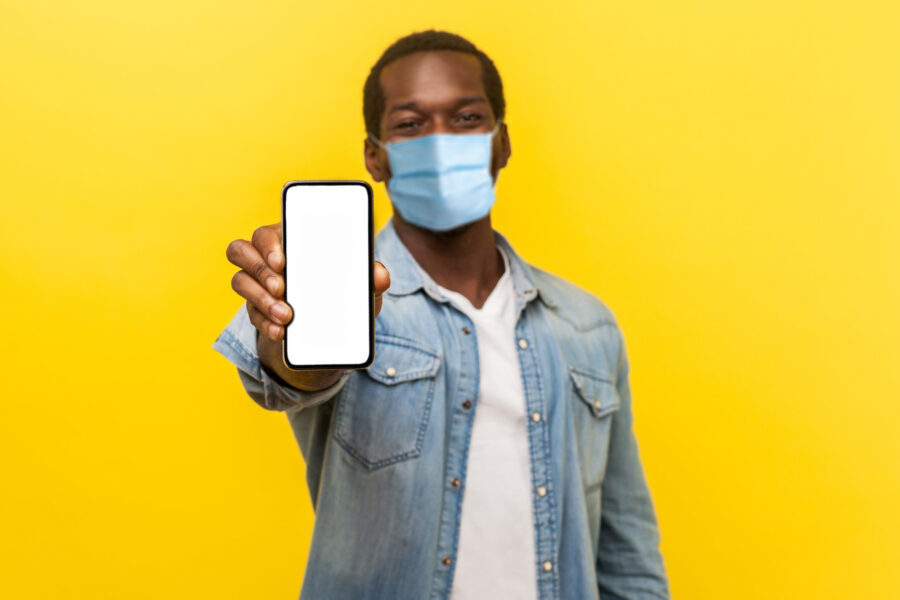Apple recently released its newest software update—iOS 13.5, which has two new coronavirus-related features you’re definitely going to want:
- Faster face unlock while wearing a mask
- Exposure Notification API: support for COVID-19 contact tracing
iOS 13.5: enhanced Face ID for coronavirus face masks
Before iOS 13.5, you may have noticed that when you tried to unlock your iPhone while you were wearing a face mask, you’d have to wait a few seconds for your iPhone to try to identify your face. After it failed to recognize your face, it would then prompt you to enter your passcode. Not the worst thing in the world, but it can certainly get annoying, especially when you’re out in public and already stressed about navigating the wild, wild west that is stores, parks, and beaches during COVID-19.
With iOS 13.5, you don’t have to wait while your iPhone attempts to identify your face—you can simply swipe up from the bottom of the screen and you’ll be able to enter your passcode immediately. While it’s certainly not as ideal as your iPhone actually recognizing you in your face mask, the update should still save you a little frustration while you’re out and about.
iOS 13.5: COVID-19 contact tracing support
Another beneficial iOS 13.5 feature is that it supports Google and Apple’s exposure notification API, which means you’ll be able to use coronavirus contact tracing apps developed by public health agencies. These apps will send you a notification if you’ve been in contact with anyone who has been diagnosed with COVID-19. Keep in mind, updating to iOS 13.5 isn’t enough—you’ll need to download a separate app in order to utilize the API.
Sometime in the future, Google and Apple will build the contact tracing capability directly into the operating systems so that users don’t need to download apps, but we aren’t exactly sure when that will be happening.
In the meantime, here are a few contact tracing apps (Apple and Android) you can download today to help reduce the spread of COVID-19:
- Healthy Together – COVID-19
- Contact Tracing
- COVID Safe Paths
- TraceTogether
In order to enable coronavirus tracing, you’ll want to:
- Download the app
- Agree to receive notifications (in case of exposure)
- Agree to share your location (even when you aren’t using the app)
- Take your smartphone with you when you leave the house
What is contact tracing?
The idea of contact tracing isn’t a new idea by any means. The public health system has been doing it the old fashioned way for ages—by interviewing infected individuals about who they’ve been in contact with. Public health officials can then notify people who may have been exposed and in theory, those people can then self-quarantine, in theory, reducing the spread of the virus. That certainly isn’t the most effective way to track the spread of the novel coronavirus, especially when you consider how fast it’s been spreading. As of May 26, 2020, there have been over 1.7 million cases in the United States. Public health agencies quickly became overwhelmed, as they simply do not have enough resources to track exposures this way. Plus, it’s not the most reliable method—sick people have no way of reporting the strangers they’ve come in contact with in the past 14 days.
Now, with the development of smart technologies, it’s possible to track the spread of COVID-19 digitally—thanks to Bluetooth technology, Apple and Google can track when smartphones are close to one another. If someone tests positive for coronavirus, they can do their due diligence and report it, and then those they’ve been close to in the past 14 days will automatically be notified of possible exposure (without compromising personal information or privacy). Then these people can self-quarantine for 14 days to ensure they don’t have spread COVID-19 if they do have it. This process can help to reduce the spread of COVID-19 and ultimately flatten the curve.
The problem with COVID-19 contact tracing apps
Until contact tracing capabilities are built directly into Apple and Android operating systems, there may be a problem with early adoption. Requiring the installation of a separate app could be enough of an obstacle to prevent people from downloading a contact tracing app. And by the very nature of how contact tracing works, if the majority of people aren’t using the app, it’s not going to work because we won’t have an accurate representation of how many people are infected and how many people have been exposed.
Will contact tracing apps compromise my privacy?
In short, privacy will most likely not be an issue with Google and Apple’s contact tracing technology. You can rest easy knowing they won’t be using GPS to track your physical location. These apps (and forthcoming built-in functionality) use Bluetooth, which picks up nearby smartphone signals and stores those “proximity events.” This helps to anonymize the connections—for instance, if you go to the grocery store, your phone may report that you were near twenty other phones but it won’t say where those interactions occurred or who with. But, as with any new technology, there may be potential bugs that these two tech giants need to work out in the upcoming months.














